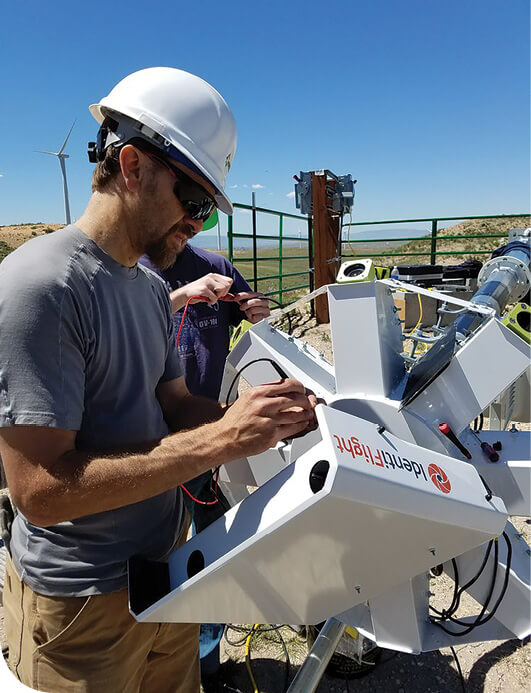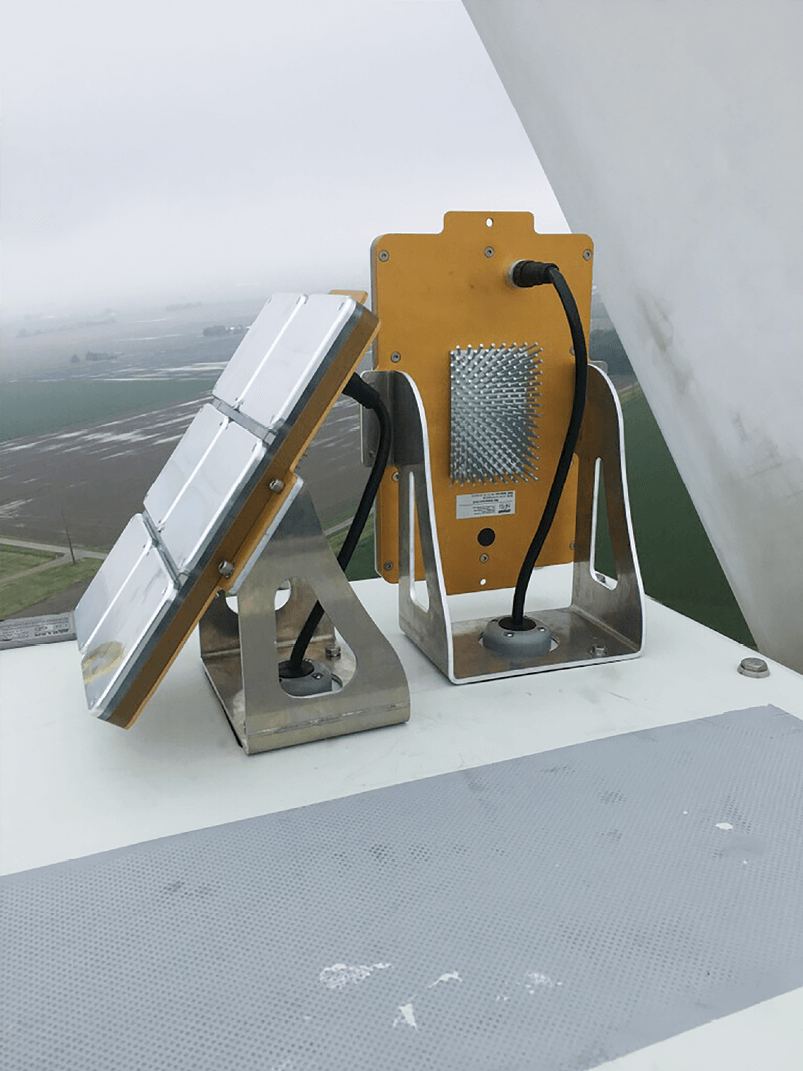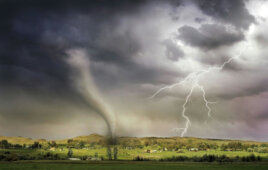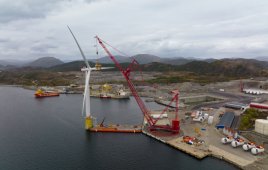Previous attempts to guard avian wildlife from wind turbines have involved project cancellations or observers with binoculars scanning the sky ready to report invaders. Good news: This next generation of equipment aimed at eagles and bats is more vigilant and more reliable.
Paul Dvorak / Editor
It’s no secret that critics of wind turbines use bird and bat takes as an opportunity to curb the wind industry and slow its progress. The actual number of deaths due to turbine rotors are lower than what they would have you believe, but still serious enough to warrant research to bring the number to near zero.

We see you. Eagles and other large birds may find friendlier skies over wind farms when devices described here go into wider service.
Recent developments in the protection of avian wildlife are significant because of the reliability they bring to the effort. For example, previous efforts to reduce eagle mishaps involved positioning people around a wind farm equipped with binoculars and radios, ready to spot potential intruders. When an eagle was identified, its location would be radioed to a central command where a curtailment order would ideally shut down the turbine nearest the bird. If everyone is alert and communicating clearly, such a system might work. Radar systems have also been tested with mixed results.
While human spotters are still used at a few sites, more reliable and always-alert systems are ready to improve on a strictly human effort. For example, one system aimed at protecting eagles can spot them a kilometer away from a wind turbine and make automated decisions. One promising system for bats signals them to think no food is near a particular turbine. So they look elsewhere.
Reasonable minds will applaud the following successes and encourage further development.
Good news for eagles

An IdentiFlight sensor on a tower includes a lower level of high-resolution cameras that look for birds in flight up to 1,000-m away. When the camera detects movement, the pan-and-tilt stereoscopic camera on the top level makes object measurements while algorithms calculate possible flight paths.
Eagles, condors, and other large birds will soon more safely fly the skies over wind farms, thanks to the development of IdentiFlight. The system, based on artificial intelligence (AI) and high-precision optics, can detect eagles up to one kilometer away and then track the bird’s speed and flight path. Should the data indicate a risk of collision with a rotor, the potentially harmful wind turbine or two can be shut down and restarted when the bird has left the area.
Automatic detection and species determination by the IdentiFlight system occurs in seconds. The system addresses the issue by blending AI with the high-precision optical technology developed by Boulder Imaging to detect eagles and protect them from harm.
It works like this: “A ring of eight stationary cameras with a wide field-of-view can detect enough pixels of an object flying up to 1,000-m away,” says IdentiFlight President Tom Hiester. “They detect motion of the object with algorithms that decide whether or not it is important. It might be an eagle or something OK to ignore, as it would be for small aircraft. When the system wants a closer look, high-resolution stereo cameras at the top level,

An IdentiFlight technician prepares a camera for deployment. Eagles are the primary target of protection for the time being but the system could be tuned to identify larger condors.
on movable pan and tilt mechanisms, can take a closer look at the bird. Because they are stereoscopic, they can measure the distance and size of the bird. In fact, it makes about 200 measurements and analyzes 80 different attributes every 250 ms,” he says.
In addition to Golden and Bald Eagles, says Hiester, the technology can be extended for use in the protection of California condors and other species of concern.
How the units will be deployed depends on what the owner feels is necessary for their risk mitigation. “In high eagle-risk areas, the classification determination is made rapidly with overlapping sensors, which means several sensors in the wind farm. Depending on rotor diameter and topography, a single camera system can cover three to five turbines. On the other hand, some owners may want to keep watch on one isolated eagle nest and so would need just one system,” says Hiester.
IdentiFlight systems are operating in pilot programs at Wyoming and Minnesota wind farms with elevated eagle activity. “These include four units operating at Duke’s Top of the World wind farm, a 200-MW project near Casper, Wyoming. Graphic displays provide audible and visual alarms to people in operations so they can make further determinations. We are working to attach its data feeds to SCADA outputs,” he adds.
Hiester says that by the time you read this, he expects a third-party performance report on the accuracy and effectiveness of IdentiFlight from The Peregrine Fund and the American Wind and Wildlife Institute.
IdentiFlight International has purchased the assets of the IdentiFlight system, from Renewable Energy Systems Americas, a firm that provides construction and operations of wind, solar, transmission, and energy storage projects. IdentiFlight International is jointly owned by Boulder Imaging and private investors affiliated with the company.
Good news for bats
Bat conservation is a tougher nut to crack because they are smaller animals than eagles. But they are worth protecting because they are voracious eaters of insects, including mosquitos and crop-destroying pests. What’s more, bats are avid pollinators.

Two NRG Systems ultrasonic transmitters are mounted atop a wind turbine nacelle. A blade is visible to the right.
Engineers at NRG Systems in Hinesburg, Vermont, have made significant headway in the area of bat conservation. The company is currently developing a Bat Deterrent System that uses a set of ultrasonic speakers to discourage bats from flying around operating wind turbines. The speakers produce ultrasonic sound in a range of frequencies that tend to negate the bat’s own signals, ultimately turning the bats away from the generated sound and the turbine rotors.
Brogan Morton, Senior Product Manager at NRG Systems, has been working with Bat Conservation International (BCI), a leading conservation group, to develop and promote this solution to bat takes at wind plants. NRG and BCI recently revealed thermal video taken at a pond test of the forthcoming Bat Deterrent Systems that provides compelling proof that the product could change the game for bat conservation in the wind industry. The video traces the bats’ flight paths at night over an insect-rich pond. The traced paths illustrate how the bats avoided the area in which their echolocation systems were jammed due to the Deterrents. When the devices were turned off, the bats quickly returned to protected areas of the pond, within 15 to 20 seconds.
Current bat protection strategies typically depended on wind turbine curtailments based on time of day and year. Although such schemes tended to reduce bat mortality, they sacrificed power production. What’s more, recent wind turbines with larger rotors can be productive in low-wind speeds, from cut-in at about 4 m/s through 6.9 m/s, which is about the wind speed limit in which bats can be active. Because they are small animals, bats tend to conserve their energy by not flying when the wind is stronger. There are also temperature thresholds below which they are not very active.
“The problem is that power curves on a few newer turbines, such as the Vestas 2-MW platform, V116 and V120, and the Gamesa G116, are shifting to the left, meaning they are intended for lower-speed wind sites. So the 6.9 mps becomes a significant production figure. The AEP numbers from farms with these turbines, where a lot of the development is now, would be reduced,” said Morton.
While turbines have been a problem for bats, a bigger concern for wildlife specialists has been White Nose Syndrome, a usually fatal bat disease. It has taken a heavy toll on several U.S. bat populations so conservationists are eager to preserve those unaffected while biologists look for a cure or the disease runs its course.
Until that time, Morton’s team will focus on keeping bats out of the high-risk areas, including the rotor circle. “Bats use ultrasound to orient, forage, and hunt. They will send out a pulse that will bounce off of a moth or whatever insect they are chasing, and a faint signal will come back to them, allowing them to locate their prey. Our Deterrent Systems generate an ambient ultrasound noise that masks the bat’s return. Since it cannot find prey in that airspace, it doesn’t want to be there.”
Morton adds, “It’s important to note that there is no impact beyond the rotor swept area. We don’t want to push bats out of their habitat. We just want to keep them away from the rotor. The ultrasound does not harm them in any way. They don’t become disoriented or fly around in circles. They just leave. And when the Deterrent is shut off, they return to the airspace in seconds.”
Furthermore, because Deterrent Systems emit ultrasound, there should be no siting impacts that might come from sounds audible to humans. The ultrasound is above human audible frequencies and there has been no effect on birds thus far.
A single turbine would require about six Bat Deterrent Systems mounted to surround the rotor. “The whole system takes about 40W to power, and because they have no moving parts, would require no maintenance. We expect a working life of at least 10 years,” said Morton.
NRG Systems has successfully completed initial testing and has begun the second phase of trials at four wind farms – three in the U.S. and one in Ontario, Canada. Morton says the Deterrents will be used at night. During the day, techs will walk the areas around the turbines looking for takes. “This baseline data will tell us how significantly NRG’s Bat Deterrent Systems reduce takes versus normal operations,” said Morton. “It is important that we conduct tests in different areas of the world with different bat species. For instance, Ontario is included in this next round of testing because it is home to affected species and has a different regulatory regime.”
“The ultimate goal is to become an avoidance device, which means we are equivalent to a 6.9 mps curtailment,” said Morton. The U.S. Fish and Wildlife Service will hopefully allow developers to avoid the take permitting process, which can be lengthy and resources intensive if they install an ultrasonic acoustic deterrent that equals avoidance level minimization.
ABOUT WHITE-NOSE SYNDROME

NRG Systems has been working with Bat Conservation International (bci.org) to preserve bat populations.
Photo: Alan Hicks, New York Dept of Environment Conservation.
Several bat populations, such as the Indiana bat, the little brown bat, and long eared bat have been falling because of the white-nose syndrome. “It is the main driver of their population decreases,” said Brogan Morten, Product Manager, NRG Systems. To make matters worse, the syndrome is spreading.
It’s a fungus that grows well in cool damp caves, places where some bat species hibernate over winter.
The fungus grows on the skin tissues of hibernating bats. It repeatedly rouses them from hibernation, causing them to consume their winter fat stores. Eventually, they starve to death before spring.
Once an infected bat enters a cave, it transmits the fungus to other bats and caves. “It is absolutely devastating to hibernacula like that in New England. Reductions of 80 to 90% have been reported. Bats produce only one to two pups a year making for a slow population recovery. So while turbines are not a primary cause of their declining numbers, taking more hurts their recovery efforts.” said Morten.
FOR FURTHER READING
Interested readers will find these additional articles on wildlife conservation useful.
New research aims to deter eagles from wind turbines
Wind energy industry announces new voluntary practices to reduce overall impacts on bats by 30%
Project update: How the wind industry is protecting bats
Looking out for our avian neighbors
Filed Under: Featured




